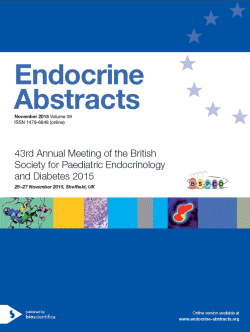
43rd Meeting of the British Society for Paediatric Endocrinology and Diabetes
e-Posters
Adrenal
ea0039ep1 | Adrenal | BSPED2015
Variation in absorption and half-life of hydrocortisone: a need to consider plasma terminal half-life in dosing schedules
Hindmarsh Peter , Charmandari Lia
ea0039ep2 | Adrenal | BSPED2015
Between patient and inter-time point variability in salivary cortisone: cortisol ratios
Park J , Lancaster G , Titman A , Peak M , Newlands P , Collingwood C , Chesters C , Moorcroft T , Hawcutt D , Didi M , Couriel J , Blair J
ea0039ep3 | Adrenal | BSPED2015
Cortisol responses to the insulin tolerance test and glucagon stimulation tests in children with idiopathic short stature and idiopathic isolated growth hormone deficiency
Alsaffar Hussain , Ahmed Iyad , Blundell Pauline , Das Urmi , Dharmaraj Poonam , Didi Mohammed , Hatchard Lynne , Ramakrishnan Renuka , Senniappan Senthil , Stirrup Kelly , Yung Zoe , Blair Joanne
ea0039ep4 | Adrenal | BSPED2015
Discordance between the cortisol dose for replacement and that required for suppression of androstenedione (A4) and 17 hydroxyprogesterone (17OHP) in congenital adrenal hyperplasia
Charmandari Evangelia , Hindmarsh Peter
ea0039ep5 | Adrenal | BSPED2015
Current dilution methods cause large variations and inaccuracies when making up 1mcg Synacthen dose
Elder Charlotte , Cross Alexandra , Sachdev Pooja , Wright Neil
ea0039ep6 | Adrenal | BSPED2015
Not always CAH: urine steroid profiling in the investigation and diagnosis of adrenal causes of neonatal hyponatraemia and failure to thrive
Lam Francis , Matei Cristina , Rumsby Gill
ea0039ep7 | Adrenal | BSPED2015
Improving patient safety: evaluating the introduction of the Annual Steroid Review and Emergency Alert Systems
Squires R , Nicoll N , Mayers R , Coxson E , Crowne E C
ea0039ep8 | Adrenal | BSPED2015
Intravenous Etomidate in the management of hypercortisolaemia due to ectopic ACTH producing thymic neuroendocrine tumor
Arya Ved Bhushan , Irvine Vanessa , Rowlands Helen , Sykes Kim , Nicolin Gary , Drake William , Storr Helen , Davies Justin H
ea0039ep9 | Adrenal | BSPED2015
Slow progressing puberty and a secreting adrenocortical tumour in a teenager.
Edate Sujata , Albanese Assunta
ea0039ep10 | Adrenal | BSPED2015
Reducing the risk of adrenal crisis: a service improvement project assessing education on adrenal insufficiency
Elliott Kirsty , Gibb Jill , Don Catriona , Conway Nicholas
ea0039ep11 | Adrenal | BSPED2015
A case of acute muscular weakness from Ectopic ACTH secreting Neuroendocrine Tumour of the Thymus
Pan Daniel , Spiking Joseph , Gupta Rahul Kumar , Agrawal Alok
ea0039ep12 | Adrenal | BSPED2015
A case of a rare adrenocortical tumour mimicking neuroblastoma
Rozario Kavitha , Ryan Fiona , Makaya Taffy



